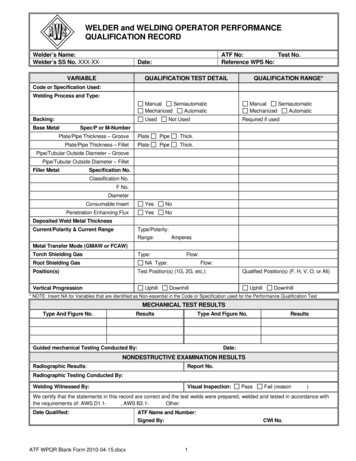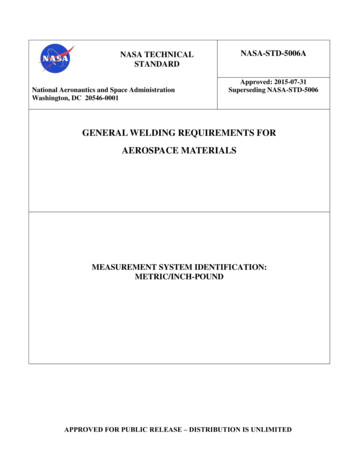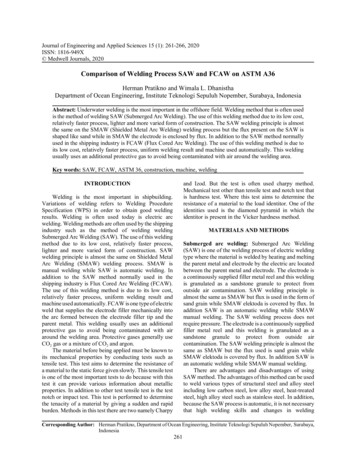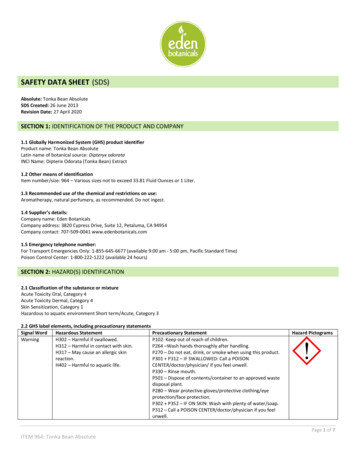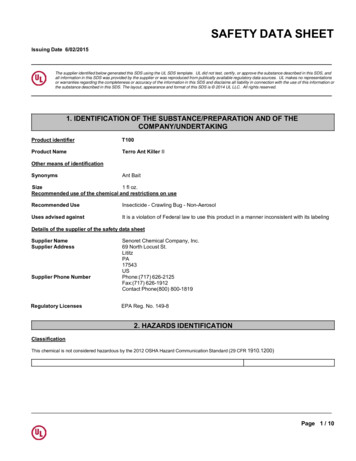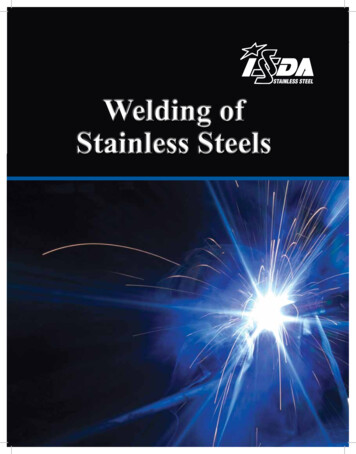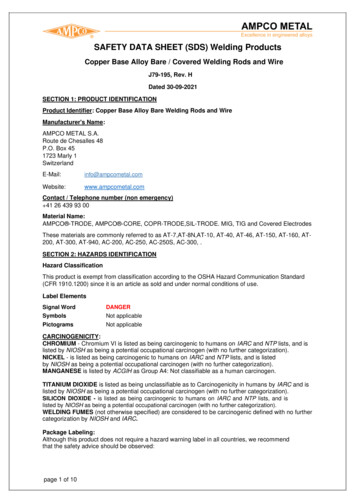
Transcription
SAFETY DATA SHEET (SDS) Welding ProductsCopper Base Alloy Bare / Covered Welding Rods and WireJ79-195, Rev. HDated 30-09-2021SECTION 1: PRODUCT IDENTIFICATIONProduct Identifier: Copper Base Alloy Bare Welding Rods and WireManufacturer's Name:AMPCO METAL S.A.Route de Chesalles 48P.O. Box 451723 Marly ampcometal.comContact / Telephone number (non emergency) 41 26 439 93 00Material Name:AMPCO -TRODE, AMPCO -CORE, COPR-TRODE,SIL-TRODE. MIG, TIG and Covered ElectrodesThese materials are commonly referred to as AT-7,AT-8N,AT-10, AT-40, AT-46, AT-150, AT-160, AT200, AT-300, AT-940, AC-200, AC-250, AC-250S, AC-300, .SECTION 2: HAZARDS IDENTIFICATIONHazard ClassificationThis product is exempt from classification according to the OSHA Hazard Communication Standard(CFR 1910.1200) since it is an article as sold and under normal conditions of use.Label ElementsSignal WordDANGERSymbolsNot applicablePictogramsNot applicableCARCINOGENICITY:CHROMIUM - Chromium VI is listed as being carcinogenic to humans on IARC and NTP lists, and islisted by NIOSH as being a potential occupational carcinogen (with no further categorization).NICKEL - is listed as being carcinogenic to humans on IARC and NTP lists, and is listedby NIOSH as being a potential occupational carcinogen (with no further categorization).MANGANESE is listed by ACGIH as Group A4: Not classifiable as a human carcinogen.TITANIUM DIOXIDE is listed as being unclassifiable as to Carcinogenicity in humans by IARC and islisted by NIOSH as being a potential occupational carcinogen (with no further categorization).SILICON DIOXIDE - is listed as being carcinogenic to humans on IARC and NTP lists, and islisted by NIOSH as being a potential occupational carcinogen (with no further categorization).WELDING FUMES (not otherwise specified) are considered to be carcinogenic defined with no furthercategorization by NIOSH and IARC.Package Labeling:Although this product does not require a hazard warning label in all countries, we recommendthat the safety advice should be observed:page 1 of 10
GHS Pictograms GHS 07, GHS 08- Contains NickelR-Phrases:Limited evidence of carcinogenic effectMaycause sensitization by skin contactToxic: danger of serious damage to health by prolonged exposure through inhalationHarmful to aquatic organisms, may cause long-term adverse effects in the aquaticenvironmentBrazing/welding fumes and vapors may cause metal fume fever (headache, dizziness,dryness, cough, nausea, and fever) and these symptoms may appear 4-12 hours afterexposure May cause irritation by prolonged inhalation of brazing/welding fumes.GHS: NickelHazard categories:Respiratory/skin sensitization: Skin Sens: 1Carcinogenicity: Carc. 2Specific target organ toxicity – repeated exposure: STOT RE 1May cause an allergic skin reaction.Suspected of causing cancer.Causes damage to organs through prolonged or repeated exposure.Hazard Statements: NickelH317May cause an allergic skin reactionH351Suspected of causing cancerH372Causes damage to organs through prolonged or repeated exposurePrecautionary Statements:P285In case of inadequate ventilation wear respiratory protectionP314Get medical advice if you do not feel wellP280Wear protective gloves/protective clothing/eye protection/face protectionP202Do not handle until all safety precautions have been read andunderstoodP260Do not breathe dust/fume/gas/mist/vapors/sprayP501Dispose of contents/container to waste treatment facility in accordance with localand national regulationsPotential Health EffectsEyes:SkinIngestionInhalation:Radiation: Arc rays from welding can injure eyes. Heat and molten metal can severelydamage eyesHeat: Spatter and molten metal can cause burn injuriesElectricity: Electric shock can killRadiation from the arc: Skin cancer has been reportedNot an expected route of entry, but if ingested product could cause serious injuryFumes: Overexposure to welding fumes may result in symptoms like metal fume fever,Dizziness, nausea, dryness of the nose, throat, or eyesACUTE HEALTH HAZARDS: See Section 11CHRONIC HEALTH HAZARDS: See Section 11MEDICAL CONDITIONS GENERALLY AGGRAVATED BY EXPOSURE: Nothing found.WARNING: This product contains or produces a chemical known to the State of California to causebirth defects (or other reproductive harm) and cancer. (California Health & Safety Code 25249.5 et seq.)page 2 of 10
WARNING: avoid breathing welding fumes and gases; they may dangerous to your health. Alwaysuse adequate ventilation and use appropriate personal protection equipment.SECTION 3: COMPOSITION/INFORMATION ON INGREDIENTSIndividual AMPCO Alloy compositions are shown on the Certification of Chemical and MechanicalProperties, when supplied, or may be found in AMPCO promotional AS -66-67440-67-7Percent(%) by -0.5Elements having a listed percentage greater than zero will be present in all grades. Elements havingpercentages starting with zero may not be present in certain grades.* This constituent, a toxic chemical, makes this product subject to the reporting requirements ofSection 313 of Title III of the Superfund Amendments and Reauthorization Act of 1986 and 40CFR Part 372. Quantity threshold for this chemical, below which reporting of releases is notrequired, is 25,000 pounds.** This constituent is reportable only if in the form of dust or fume.Note: Chromium, lead and nickel have been identified as potential human carcinogens. This material isclassified as not hazardous under OSHA regulationsCoating Material:ComponentOSHA PELACGIH-TLV8-Hr TWA8-Hr TWAMilligrams Per Cubic MeterCAS NumberPercentSodium Silicate6834-92-026.9NoneNoneCryolite(as Fluoride)15096-52-351.02.52.5Petroleum oneSilica Sand7631-86-93.210%Si02 20.12.7None155NoneFeldsparNuisanceDust Respirablepage 3 of 10
The decomposition of this coating during the welding process should not produce levels of theabove components in amounts above the permissible exposure limit. However, if use in improperlyventilated or exhausted areas should generate fumes, vapors or dust, use approved (NIOSH) respiratorsonly.Fluorides are highly irritating to the eyes, nose and throat. Overexposures have been associated withcumulative bone damage. Long-term silica exposure is associated with a lung disease called silicosis.The degree of the hazard depends upon the concentration, size and length of exposure.Incomplete combustion may produce carbon monoxide and/or carbon dioxide: odorless, colorless gaseswhich are asphyxiants.None of the coating components are subject to the reporting requirements of Section 313 of Title III of theSuperfund Amendments and Reauthorization Act of 1986 (SARA) and 40 CFR Part 372. This material isclassified as not hazardous under OSHA regulationsSECTION 4: FIRST AID MEASURESEye ContactNo need for first aid is anticipated under normal use conditionsFlush well with running water to remove particulate. Get medical attention.InhalationNo need for first aid is anticipated under normal use conditions.If symptoms develop following exposure to fumes or dusts released from the processing of the casting(e.g. machining, grinding, sawing, blasting, polishing, buffing, brazing, soldering, welding or thermalcutting), immediately remove person from exposure. Seek medical attention if symptoms persist.SkinNo need for first aid is anticipated under normal use conditions.Vacuum off excess dust. Wash well with soap and water. Avoid blowing particulate into the atmosphere.Contact with these grades in the molten condition will cause severe burns. Get medical attention.IngestionNo need for first aid is anticipated under normal use conditions.Seek medical attention if large quantities of material have been ingested.Most Important Symptoms and Effects, both Acute andDelayed None expected under normal conditions of use.Dust or fumes generated by machining, grinding, sawing, blasting, polishing, buffing, brazing, soldering,welding or thermal cutting of the casting may produce airborne contaminants (see Sections 8 and 11)that are hazardous.Indication of Immediate Medical Attention and Special TreatmentNeeds Not applicableSECTION 5: FIRE FIGHTING MEASURESWelding consumables are not flammable. The welding arc and sparks can ignite flammable material.Do not weld in the presence of flammable materialsSuitable Extinguishing MediaUse suitable extinguishing methods for surrounding fireSpecial Hazards Arising from the SubstanceNot applicableSpecial Protective Actions for Fire FighterNot applicableFlash Point: Not ApplicableMethods Used: Not ApplicableFlammable Limits: LFL: Not ApplicableUFL: Not ApplicableExtinguishing Media: See BelowSpecial Fire Fighting Procedures: Solid, massive form is not combustible under normal conditions.Use firefighting methods that are appropriate for surrounding fire.page 4 of 10
Small chips, fine turnings and dust may ignite readily. Use coarse water spray on chips, turnings, etc. Useclass D extinguishing agents or dry sand on fines. DO NOT use halogenated agents on small chips orfines. Dust clouds may be explosive. PREVENT FORMATION OF A DUST CLOUD.Molten metal alloys may explode on contact with water. They may also react violently with water, rustand certain other metal oxides (e.g. oxides of copper, iron and lead).SECTION 6: ACCIDENTAL RELEASE MEASURESPersonal Precautions, Protective Equipment and Emergency ProceduresNo special measures requiredEnvironmental PrecautionsNot applicableMethods and Material for Containment and Clean-upNot applicableSECTION 7: HANDLING AND STORAGEPrecautions for Safe HandlingNo special requirements.Conditions for Safe Storage, Including Any IncompatibilitiesNo special storage requirements.SECTION 8: EXPOSURE CONTROLS AND PERSONAL PROTECTIONRespiratory Protection: If exposure above the PEL or TLV, NIOSH approved respirator for fume ordust, dependent upon the source of airborne contaminant.Ventilation: Required if dust or fume created in handling or working on this material.Exhaust: Required if dust or fume created in handling or working on this material. MechanicalGeneral: As above to reduce airborne dust or fume.Protective Gloves: Required for melting, grinding, cutting or welding operations. Select gloveapproved for the specific operation.Eye Protection: Required for melting, grinding, cutting or welding operations. Minimum requirement ofsafety glasses with side shields for these operations. Melting and welding may require special eyeprotection including face shields and specially tinted glass and/or welder's helmet. Grinding operationsmay require face shields.Other Protective Clothing or Equipment: Use leather or equal protective gloves and body clothingwhile welding as required for all other operations performed on the product.Work/Hygiene Practices: Use ear muffs or plugs if the noise level is above 90 dBA whenperforming operations on the product. Always evaluate the operations done on this productin accordance with OSHA or relevant state, federal or local standards.Occupational Exposure LimitsDust or fumes generated by machining, grinding, sawing, blasting, polishing, buffing, brazing,soldering, welding or thermal cutting of the casting may produce airborne contaminants with thefollowing Occupational Exposure Limits (OELs):ComponentAluminum**page 5 of 10CASNumber7429-90-5OSHA PELTWAACGIH TLV TWAPercent %Milligrams Per Cubic Meter (mg/m3)0-20
Metal & Insoluble 7440-50-8IronIron OxideLead*Metal & -96-5CASNumberDustFume0-2155 (R)1 (R)1 (R)0.10.20.10.0210.110.2105 ume0-14DustFume5OSHAPEL8-HrTWAPercent %0.020 (R)0.1 (I)ACGIH TLV 8-Hr TWAMilligrams Per Cubic Meter -21-3TinOxide & Inorganic 2ElementalInsoluble0-30-4Total DustRespirable0-2011.5 (I)10.2 (I)None Established1550.17440-66-60-42Total DustFume1550-0.5Elements having a listed percentage greater than zero will be present instarting with zero may not be present in certain alloy grades.50.110510 (STEL)5all alloy grades. Elements having percentages* This constituent, a toxic chemical, makes this product subject to the reporting requirements of Section 313 of Title III of theSuperfund Amendments and Reauthorization Act of 1986 and 40CFR Part 372. Quantity threshold for this chemical, below whichreporting of releases is not required, is 25,000 pounds.** This constituent is reportable only if in the form of dust or fume.Exposure Limit AbbreviationsNE None EstablishedACGIH TLV American Conference of Governmental Industrial Hygienists Threshold Limit Value , 2015 EditionOSHA PEL Occupational Health and Safety Administration Permissible Exposure LimitTWA Time Weighted AverageSTEL Short Term Exposure Limitpage 6 of 10
C Ceiling Limitmg/m3 milligram of substance per cubic meter of airR Respirable fraction of particulate sampledI Inhalable fraction of particulate sampledAppropriate Engineering ControlsIn the solid state, no special requirements are necessary. If processes such as machining, grinding,sawing, blasting, polishing, buffing, brazing, soldering, welding or thermal cutting are used on thecasting, local exhaust ventilation may be required to maintain concentrations of airborne hazardousingredients below the applicable exposure limits.Personal Protective EquipmentEye ProtectionWear safety glasses with side-shields if there is a risk of particles getting ineyes Skin protectionNo chemical protective clothing is required. If material is processed, use appropriate protective clothingand gloves for the application.Respiratory ProtectionIn the solid state, no special requirements are necessary. Airborne dust or fumes can be generated bymachining, grinding, sawing, blasting, polishing, buffing, brazing, soldering, welding or thermal cuttingof the castings. Respiratory protection may be necessary if concentrations of these hazardousingredients exceed the applicable exposure limits. In these cases a NIOSH approved respirator shouldbe selected based on the form and concentration of the contaminant in air.SECTION 9: PHYSICAL AND CHEMICALPROPERTIES AppearanceThe welding consumable consists of a wire strip, solid wire rod withor without a flux based core or coatingOdorNotapplicableOdor threshold pHNotapplicableMelting PointNot applicableInitial boiling point & boiling range1742-2050º F (950-1121º C)Flash PointNotapplicableEvaporation ility in WaterNotapplicablePartition CoefficientNotapplicableAuto-Ignition TemperatureNot applicableDecomposition TemperatureNot applicableFlammabilityUpper/Lower flammability or explosive limitsVapor PressureVapor DensityRelative Densitypage 7 of 10
ViscosityNot applicableSECTION 10: STABILITY AND REACTIVITYReactivityChemical StabilityPossibility of Hazardous ReactionsConditions to avoidIncompatible MaterialsHazardous Decomposition ProductsInert, not reactiveStableWill not occurNone knownNone knownNone expected under conditions of normal use.SECTION 11: TOXICOLOGICAL INFORMATIONThis product as sold is an article but processing may release hazardous substances. Informationabout these components is supplied.Acute ToxicityCopperEye and respiratory irritation may occur. High exposure to copper dust may causegastrointestinal effects due to oral ingestion.NickelOne study showed severe lung and kidney damage following exposure to extremely highlevels of nickel powder.Skin Corrosion / IrritationNone expectedSerious Eye Damage or IrritationNone expectedRespiratory or Skin SensitizationCobaltMay cause allergy or asthma symptoms or breathing difficulties if inhaled. Contact allergicdermatitis may occur.NickelContact allergic dermatitis may occur.Germ Cell MutagenicityNickelChromosomal aberrations and in vitro and in vivo testing has shown that nickel is genotoxic(ASTDR)CarcinogenicityAluminumNot listed by IARC, NTP or OSHACobaltListed by IARC (possibly carcinogenic to humans-Group 2B). Not listed by NTP or OSHA.CopperNot listed by IARC, NTP or OSHAIronNot listed by IARC, NTP or OSHAManganeseNot listed by IARC, NTP or OSHANickelListed by IARC (possibly carcinogenic to humans-Group 2BA) and NTP (known to be ahuman carcinogen). The strongest evidence for carcinogenicity is for sulfidic nickel formsand the evidence for oxidic forms of nickel are the weakest. There is no evidence thatmetallic nickel is associated with nasal or lung cancer (ASTDR).Reproductive ToxicityNone expectedSpecific Target Organ Toxicity-Single ExposureCopperA few studies have shown copper to cause metal fume fever, a condition characterized bychills, fever, muscular pain, nausea, and vomiting but these are limited in number anddetails. Studies have reported upper respiratory tract irritation, metallic taste sensationand nausea.NickelOne study showed severe lung and kidney damage following exposure to extremely highlevels of nickel powder.page 8 of 10
Specific Target Organ Toxicity-Repeated ExposureAluminumThere is some evidence that aluminum may accumulate in the body with long-termexposure. Lung changes have been reported in workers exposed to high levels ofaluminum dust. Some studies have indicated that there may be subtle neurological effectsfollowing long –term exposure to aluminum.CobaltAnimal studies have shown respiratory effects following inhalation exposure (lung edema,decreased pulmonary function). Transient myocardial changes have also been reported.Studies have shown asthma and pulmonary function changes in workers in the cementedtungsten carbine industry and cobalt is thought to play a significant role in these effectsalthough it is not the only substance these workers were exposed to.IronProlonged exposure may lead result in iron deposits in the lung, a condition known assiderosisManganeseInflammatory changes in the lung were found in monkeys exposed to manganese dioxidevia inhalation for 10 months. At high exposure levels (greater than 5 mg/m3), manganism(chronic manganese poisoning) has been reported in workers. Symptoms of manganisminclude sleepiness, weakness in the legs, a mask-like facial appearance, emotionaldisturbances and a spastic gait. High levels of pneumonia have also been reported inworkers inhaling large amounts of manganese dust and fume. In some studies, manganesehas been associated with longer reaction times, hand steadiness and eye-handcoordination. Effects appear to be more pronounced with exposures to respirable sizedparticles.Nickel (elemental and nickel oxideAnimal studies have shown lung changes and inflammation.Aspiration HazardBased on the physical form, the product is not expected to be an aspiration hazard.SECTION 12: ECOLOGICAL INFORMATIONToxicityEco toxicity is expected to be minimal since the casting is a solid with low water solubility.Persistence and DegradationNot applicableBioaccumulationNot applicableMobility in SoilNot applicableEnvironmental FateNot applicableSECTION 13: DISPOSAL INFORMATIONThis product is not considered to be hazardous waste according to US RCRA and Canadian regulations.Recover or recycle if possible. Dispose of according to federal, state and local regulations. Dust collectedfrom casting processing operations (e.g. machining, grinding, sawing, blasting, polishing, buffing,brazing, soldering, welding or thermal cutting) may be classified as a hazardous waste. Consult federal,state and local regulations.SECTION 14: TRANSPORTATION INFORMATIONU.S. Department of Transportation (DOT)Product is not regulatedInternational Maritime Dangerous Goods (IMDG)Product is not regulatedTransport in bulk according to Annex II of MARPOL 73/78 and the IBC CodeProduct is not regulatedInternational Civil Aviation Org. / International Air Transport Assoc. (ICAO/IATA)Product is not regulatedpage 9 of 10
SECTION 15: REGULATORY INFORMATIONIf this product is reformulated or further processed, the regulatory status of the components listed in thecomposition section of this sheet may be altered. The following regulatory information may not becomplete and should not be relied upon as the sole source of information regarding regulatoryresponsibilities.Occupational Health and Safety AdministrationThis product is an article as sold. Dust or fumes generated by machining, grinding, sawing, blasting,polishing, buffing, brazing, soldering, welding or thermal cutting of the casting may produceairborne contaminants that are regulated by OSHA.TSCA Chemical InventoriesThis product is an article as defined by TSCA regulations, and is exempt from TSCA Inventorylisting requirementsOther Regulatory InformationNPRIChemicalAluminum(fume or dust)CobaltCopperIronManganeseNickelCAS -105-1231-111-4CERCLARQ (lbs)Section A1ACaliforniaProp 65CarcinogenCarcinogenCAS- Chemical Abstract Service- Registry NumberEINECS - European Inventory of Existing Commercial Chemical SubstancesCERCLA RQ (reportable quantity) - if a value is listed then releases of particles, 100 μm in size, to the environment may requirereporting under CERCLA Sections 102-103 (40 CFR Part 302)Section 313 - if '313' is listed then may be subject to the reporting requirements found under EPCRA Section 313 (40 CFR Part 372)NPRI (National Pollutant Release Inventory) Threshold Category - if 1A or 1B is listed, may be subject to reporting underthe Canadian Environmental Protection Act, 1999California Prop 65 - if listed WARNING: This product contains chemicals known to the State of California to cause cancer.These products are not believed to contain any substances that meet the notification requirements found under EPCRA Sections 302or 304 (40 CFR Part 355) nor subject to the accidental release prevention requirements under CAA 112(r) (40 CFR Part 68).SECTION 16: OTHER INFORMATIONThis MSDS is intended to be used as a guide to the appropriate handling, storage, and use of thisproduct by an adequately trained person. AMPCO METAL S.A. is not responsible for the misuse,mishandling or improper storage of this material by the user. This product is exempt from classificationaccording to the OSHA Hazard Communication Standard (CFR 1910.1200) since it is an article as soldand under normal conditions of use.Dust or fumes generated by machining, grinding, sawing, blasting, polishing, buffing, brazing, soldering,welding or thermal cutting of the casting can produce airborne contaminants that are hazardous.Consult the Safety Data Sheet (SDS) for this product for further information.WARNING: This product contains chemical(s) known to the State of California to cause cancer.page 10 of 10
SAFETY DATA SHEET (SDS) Welding Products Copper Base Alloy Bare / Covered Welding Rods and Wire J79-195, Rev. H Dated 30-09-2021 SECTION 1: PRODUCT IDENTIFICATION Product Identifier: Copper Base Alloy Bare Welding Rods and Wire Manufacturer's Name: AMPCO METAL S.A. Route de Chesalles 48 P.O. Box 45 1723 Marly 1 Switzerland



